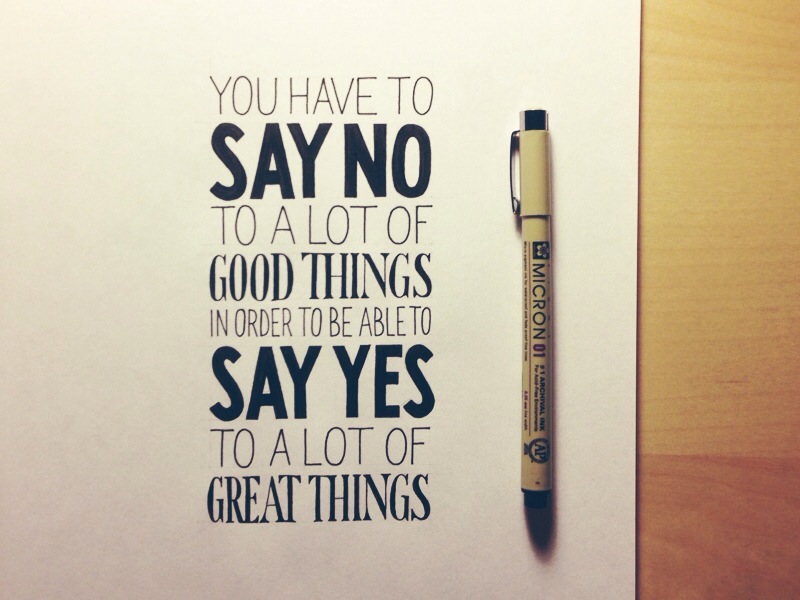
Hands up if you say yes to everything? It’s time to learn the art of saying no.
Over-commit yourself and then wind up stressed and exhausted with a nagging guilt that you haven’t actually done anything to the best of your ability?
Sound familiar?
FOMO step aside. This is about a deep-seeded sense of duty – or politeness (or both?) that leaves you incapable of defending yourself when someone asks one more favour, invites you to an unmissable event or piles work on your desk with an unrealistic deadline.
The art of saying no
Learning to say no is an art (and not one that I have fully perfected myself by the way!). No is a word to protect you from the dangers of saying yes. I’m still learning…
Most of us associate the the word ‘no’ with negativity. It’s the word we heard as a child in response to almost everything we wanted to do. As an adult, hearing someone say ‘no’ sounds abrupt and rude. How did we get to this?
Of course there is an element of not wanting to miss out on stuff. Since I did SAS Who Dares Wins, I’ve been asked to do so many fun things, write articles, meet incredible people, attend events, do talks, sign up for new challenges. Those new opportunities are so enticing and of course I want to do as many of them as I can. But I know I can’t. And I’m such a perfectionist that I only ever wind up feeling deflated if I haven’t executed every one of them with military precision and a high energy attitude.
So, let’s re-frame how we think of the word ‘no’.

Think of it as a shield that you can use to deflect exhaustion, poor performance, regret and disappointment.
Think of it as a means to turn down opportunities in the short-term for even bigger opportunities in the long-term.
Use it as a sense-checker so you can be as proud of the things you haven’t done as the things you have done.
Think of closing the door on one thing as a direct route to opening the door to something else.
Of course, in order to make a decision either way, you have to know, use and trust your instincts. But here are some of the rational strategies I use, because instincts don’t always present themselves in front of you holding a road sign with a clear direction.

1. Define your priorities.
Then when new opportunities present themselves, you’ll know if they support or conflict with how you want to spend your time. For me, if something clashes with my training schedule, or means I have to spend entire days indoors behind a desk, I know I don’t really want to do it.
2. Practice the art of saying no.
Practice makes perfect. Saying “no” as often as you can is a great way to get better at it and more comfortable with saying the word. Say it into the mirror, say it to a friend who can give you feedback on how convincing you are, get really assertive when someone asks if you take sugar in your coffee. Be firm, but smile broadly.
3. Don’t apologize.
Why do we always say “I’m sorry but …”?! Politeness is important but constantly being apologetic is weak. Be firm, and unapologetic about guarding your time. It is YOURS to guard. When it’s time to say no, you need to avoid phrases like “I don’t think I can” or “I’m not certain.” Using limp phrases instead of saying no will often be considered a yes. When it’s time to say no, just say no!
4. Say no to your boss.
This is the hardest one for sure. It’s your boss, right? Say no and it’s like a declaration that you can’t do your job. Sorry what? In fact, it’s the opposite — explain to your boss that by taking on too many commitments, you are weakening your productivity and jeopardizing your existing commitments.
5. Pre-empting.
It’s easier to pre-empt requests than to say “no” to them after the request has been made. So get ahead of the game. “Look guys, just to let you know, my week is booked full with some urgent projects and I won’t be able to take on any new requests.” Job done.
If you can’t find it within you to say no, you’re on a fast-track to stress, burnout, and even depression (three things that hinder your emotional intelligence). Learning the art of saying no will give you the mental and emotional space to stick to your priorities, allow you to get perspective on the bigger picture AND empower you to make decisions that work for YOUR life. There’s a lot to be gained from being a little selfish every now and again!
Read Next: Finding time to exercise, when you’re schedule is already jam-packed!

I’m thrilled to be writing a monthly column for @dailystruggleuk and each month, I’ll be sharing some of the strategies that I use on a daily basis to train for general physical and mental preparedness. I do not believe that I am the most talented person out there, or even the strongest, fastest or fittest, but I do have an inner drive to be the best I can at whatever I do – and I never, ever give up.
Follow Vicki on Instagram @vickianstey and @barreworks